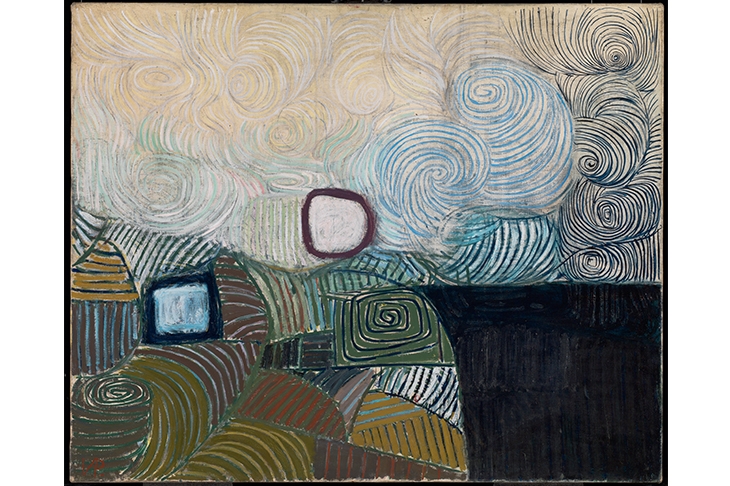Victor Pasmore once told me how he greeted Pablo Picasso at Victoria station. The great man had come to Britain in 1950 to attend a communist-sponsored peace congress in Sheffield. In person Pasmore found him surprisingly different from the solemn art-historical giant suggested by books. ‘He did nothing but joke all the time, non-stop, and he was no more a communist than the local fairy.’ Instead, Pasmore felt, ‘Picasso was 100 per cent anarchist.’
Something similar could be said about Pasmore himself, as can be seen from a fine exhibition devoted to his work from the 1930s to the ’60s at the Djanogly Gallery, Nottingham (moving on to Pallant House, Chichester, on 11 March). Few artists made more abrupt stylistic swerves. Consequently, his career was a thesaurus of all the possibilities open to a 20th-century painter, from dingy social realism to millenarian modernism.
Pasmore (1908–98) began, he explained, as a ‘sort of impressionist’, subsequently dabbling briefly with ‘imitation cubist and fauvist pictures’. This flirtation with the avant-garde seemed to lead nowhere, so ‘I gave it up and went back to the old masters.’ In 1937, with two friends, William Coldstream and Claude Rogers, Pasmore founded the hugely influential Euston Road School, dedicated to carefully calibrated depictions of their mid-century British surroundings. But he shied away from that orthodoxy too.
The first pictures in the exhibition, dating from the 1930s, are somewhat in the manner of Sickert or Degas. Next, during and immediately after the war, Pasmore produced swooningly romantic landscapes — then suddenly turned to abstraction. For a while after that he concentrated on geometric sculptural constructions, and at one point designed a whole neighbourhood of a New Town — Peterlee in County Durham — before returning to abstract painting.
Where in all this, you might wonder, was the true Pasmore? Actually, his essential talent is not hard to discern in each transformation — although that does not mean that all his incarnations were equally successful.
To my mind, he was at his peak just as he was about to cross the border between figurative art and abstraction. Some of the paintings he did at that point, in the mid-1940s, are almost too seductively enjoyable. There may be greater 20th-century British paintings than ‘The Quiet River: The Thames at Chiswick’ (1943–4), for example, but there aren’t many in which every dab of paint is so subtly right. And it is, just like Pasmore’s later non-figurative works, an image of nothing much: mist, a hint of pink in the sky, a gleam on the water, a few posts, someone cycling by.
‘Green Landscape with Gate’ (c.1943) depicts just what the title says, a mass of vegetation with a small wooden gate in the middle, and yet you could look at it for ages, as you can a good Jackson Pollock, because of the energy and rhythm of brushstrokes that make up trees and hedge. Pasmore declared that ‘abstract’ wasn’t a good word to describe what he then did. ‘But there isn’t really another one. I call it independent painting: that is, art that is independent like music.’
When he ‘went abstract’ in the late 1940s it caused consternation to erstwhile supporters such as Kenneth Clark, and one can understand why. From painting marvellously in the manner of Whistler and Turner (the latter his hero from boyhood), Pasmore suddenly switched to imitating Paul Klee and cubism — with clunky results and a sharp drop in quality.
As time went on, Pasmore found himself becoming an abstract artist, but he never quite regained the shimmering delicacy of his finest landscapes. On the other hand, his feeling for space and interval, as distinctive as a composer’s sense of melody, is as recognisable as a fingerprint in an abstraction such as ‘Development in Green and Indigo No. 2’ (1965).
The best of the sculptures have it too. And I’d like to see his Apollo Pavilion at Peterlee in the flesh — a model is displayed in the exhibition. This, a functionless structure like a walk-though sculpture in the middle of a housing estate, is almost a parable of the perils of post-war modernism. Naturally, it was immediately vandalised by local teenagers and later almost demolished as an eyesore. The luxuriant graffiti, though, didn’t much bother Pasmore. After a visit in the 1980s, he described the effect as ‘a colourful exhibition of free child’s art’.
Even if every stylistic turn Pasmore took was not equally fertile, it is hard not to admire his boldness. Once he was asked whether the text of the bits of newspaper stuck on his collages was important. No, he replied — but, he added, ‘I try to be instructive’, pointing at a headline glued on one that read simply ‘Liberty!’ Not a bad watchword for any artist.






Comments